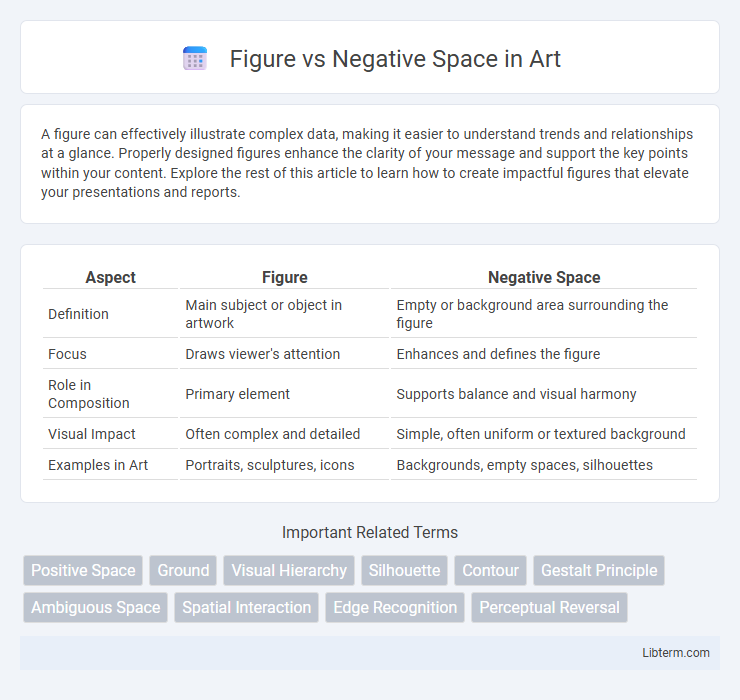A figure can effectively illustrate complex data, making it easier to understand trends and relationships at a glance. Properly designed figures enhance the clarity of your message and support the key points within your content. Explore the rest of this article to learn how to create impactful figures that elevate your presentations and reports.
Table of Comparison
| Aspect | Figure | Negative Space |
|---|---|---|
| Definition | Main subject or object in artwork | Empty or background area surrounding the figure |
| Focus | Draws viewer's attention | Enhances and defines the figure |
| Role in Composition | Primary element | Supports balance and visual harmony |
| Visual Impact | Often complex and detailed | Simple, often uniform or textured background |
| Examples in Art | Portraits, sculptures, icons | Backgrounds, empty spaces, silhouettes |
Understanding Figure and Negative Space
Understanding figure and negative space is essential in design and art, where the figure refers to the main subject or object, and negative space is the area surrounding it. Proper manipulation of negative space enhances visual balance, depth, and emphasis on the figure, creating a more impactful composition. Mastery of this concept allows artists and designers to convey messages clearly while maintaining aesthetic appeal.
The Role of Negative Space in Design
Negative space plays a crucial role in design by enhancing visual clarity and emphasizing the primary subject, allowing for a balanced composition that guides the viewer's focus. Effective use of negative space creates breathing room, prevents clutter, and improves readability, which is essential in branding, user interface design, and print layouts. Designers leverage negative space to craft subtle shapes or hidden messages, enriching the overall narrative and engagement within a design.
How Figure Influences Visual Perception
Figure influences visual perception by directing attention towards the main subject, enabling clear recognition and interpretation of shapes within a composition. The prominence of the figure establishes hierarchy, contrast, and spatial relationships, shaping how viewers organize and understand visual information. Effective use of figure enhances depth perception and guides the observer's eye movement, contributing to a cohesive and engaging visual experience.
Balancing Figure and Negative Space
Balancing figure and negative space is essential for creating visually compelling compositions in design and art. Effective use of negative space enhances the prominence of the figure, providing clarity and focus while preventing clutter. Mastering this balance improves visual hierarchy and ensures that the viewer's attention is naturally guided to the focal elements without overwhelming the overall layout.
Techniques to Create Effective Negative Space
Effective negative space techniques include simplifying shapes to enhance contrast and using asymmetrical balance to direct viewer focus. Strategic placement of elements creates visual breathing room, allowing the figure to stand out more prominently against the background. Mastering these techniques improves composition clarity and adds depth by emphasizing the relationship between positive and negative spaces.
Common Mistakes with Figure and Negative Space
Common mistakes with figure and negative space often include confusing the two, leading to designs where the background overwhelms the subject or vice versa. Designers frequently neglect negative space, causing cluttered compositions that lack visual balance and impede message clarity. Overemphasis on positive space can result in designs that feel cramped, whereas strategic use of negative space enhances readability and directs focus effectively.
Figure-Ground Relationship Explained
The figure-ground relationship is a fundamental principle in visual perception where the figure refers to the main object of focus, and the negative space represents the background or surrounding area. This relationship enables the viewer to distinguish shapes and forms by organizing visual elements into a cohesive whole, with the figure typically seen as the prominent, positive space. Effective use of figure-ground interplay enhances clarity and balance in design by manipulating contrast, edges, and spatial arrangement to guide visual attention.
Enhancing Visual Hierarchy Using Negative Space
Enhancing visual hierarchy through negative space involves strategically using empty areas to emphasize key design elements, creating clear focal points that guide viewer attention. Negative space improves readability by separating content and reducing visual clutter, which makes important figures stand out more prominently. Employing balanced negative space around and within elements increases contrast and spatial relationships, strengthening the overall composition and communication effectiveness.
Famous Examples of Figure and Negative Space in Art
Famous examples of figure and negative space in art include M.C. Escher's "Sky and Water I," where birds and fish alternate seamlessly between figure and background roles, demonstrating complex visual perception. Another notable work is Rene Magritte's "The Treachery of Images," which plays with the viewer's understanding of representation through the interplay of objects and their surrounding space. The Rubin Vase illusion also exemplifies figure-ground reversal, showcasing how human perception can switch between seeing a vase (figure) and two faces (negative space).
Practical Tips for Mastering Figure and Negative Space
Mastering figure and negative space enhances visual clarity by balancing the subject with its surrounding area, which improves overall composition. Practice identifying and separating shapes by sketching simple objects and experimenting with coloring the negative space to understand its impact. Using grids or templates can help maintain proportion and spatial relationships, allowing artists to create more dynamic and visually engaging designs.
Figure Infographic

 libterm.com
libterm.com